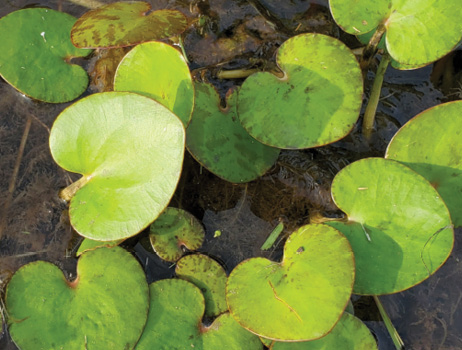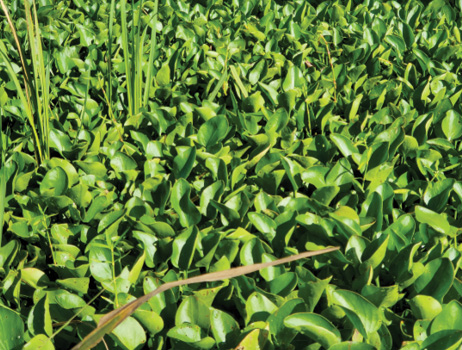Frog’s-Bit | Limnobium spongia
Emergent | Native



native frog’s-bit (right). Veins of water hyacinth run parallel,
while frog’s-bit veins expand outward.
This frog’s-bit species is native to Mississippi and is characterized by small, thick, leathery leaves that are rounded and heart shaped. They are shiny and bright green on the upper surface and reddish on the underside. The leaves feel spongy.
The leaf stalk is slender and has ridges. Its roots are white. The plant produces a flower with three white petals and a yellow center.
Frog’s-bit can be found rooted in shallow marginal areas or free-floating in deeper areas. When floating offshore, it often co-occurs with other species, which it uses to maintain position without being blown to shore.
This species is often confused with the invasive species water hyacinth (Pontederia crassipes). However, water hyacinth has parallel vein structure compared to expanding veins on frog’s-bit. When water hyacinth flowers are present, the species can easily be distinguished by its showy purple flower stalks.
Management Value
The seeds of frog’s-bit are eaten by ducks and possibly other animals. The plant serves as habitat for invertebrates. Frog’s-bit rarely causes problems as a shoreline species; however, its floating growth form can create dense mats that may block sunlight, which causes an oxygen depression and has the potential to kill fish. It is not recommended as a beneficial addition to pond management.
Recommended Controls
It is best to apply herbicides when plants are actively growing.
Option 1: Imazapyr (2.0-pound formulation). For each gallon of water, mix 2.5 ounces imazapyr and 1.3 ounces non-ionic surfactant. Spray to wet all exposed plants. Do not exceed annual herbicide rate limits as stated on the product label.
Option 2: Imazamox (1.0-pound formulation). For each gallon of water, mix 2.0 ounces imazamox and 1.3 ounces non-ionic surfactant. Spray to wet all exposed plants. Do not exceed annual herbicide rate limits as stated on the product label.
Option 3: Triclopyr (3.0-pound formulation). For each gallon of water, mix 2.5 ounces triclopyr and 1.3 ounces non-ionic surfactant. Spray to wet all exposed plants. Do not exceed annual herbicide rate limits as stated on the product label.
Read and follow all chemical label instructions, especially the section on the use of personal protection equipment.

The information given here is for educational purposes only. References to commercial products, trade names, or suppliers are made with the understanding that no endorsement is implied and that no discrimination against other products or suppliers is intended.
Publication 3735-24 (POD-11-23)
By Wes Neal, PhD, Extension/Research Professor, Wildlife, Fisheries, and Aquaculture; Dennis Riecke, Fisheries Coordinator, Mississippi Department of Wildlife, Fisheries, and Parks; and Gray Turnage, PhD, Assistant Research/Extension Professor, GeoSystems Research Institute.
The Mississippi State University Extension Service is working to ensure all web content is accessible to all users. If you need assistance accessing any of our content, please email the webteam or call 662-325-2262.


